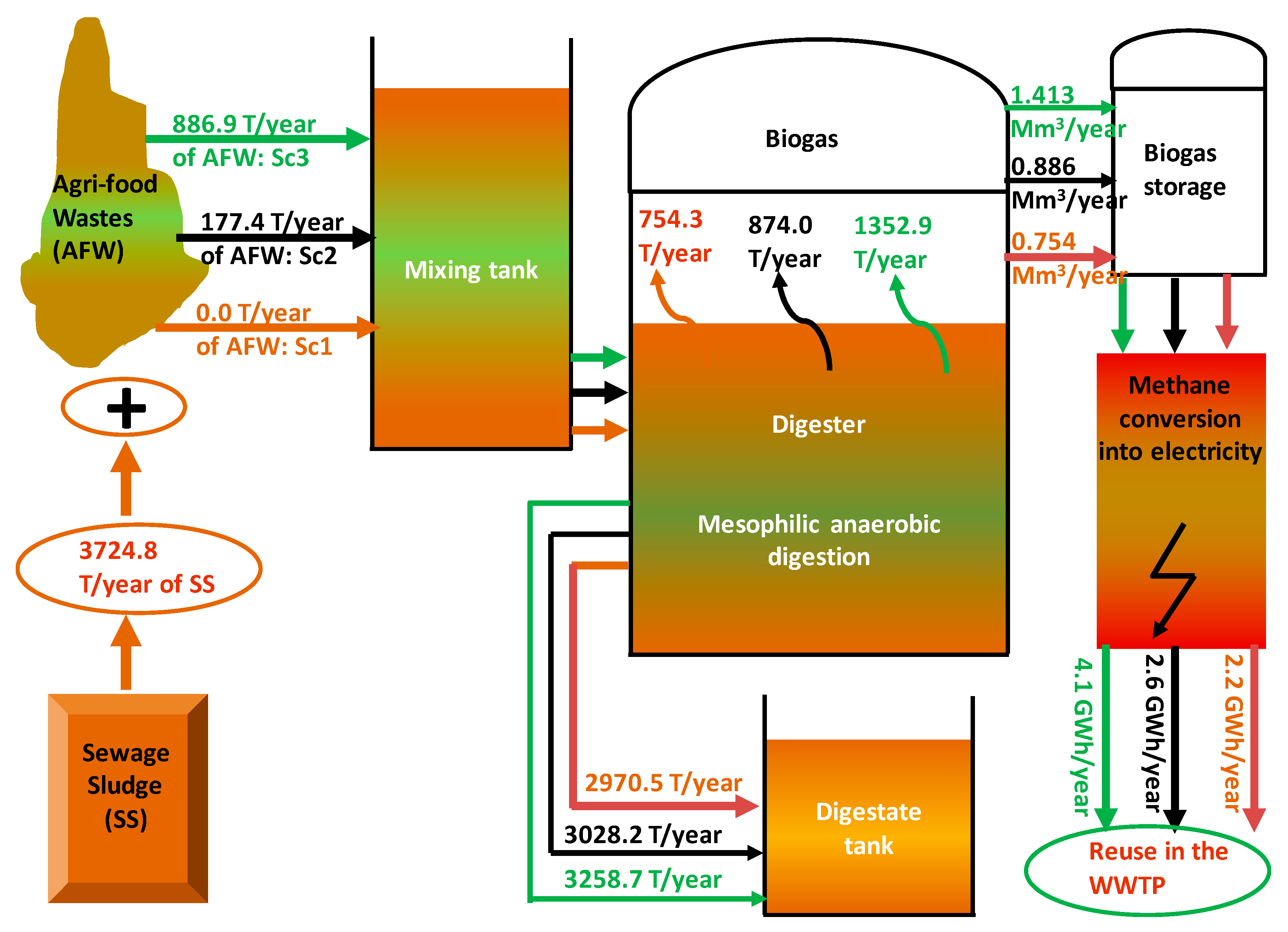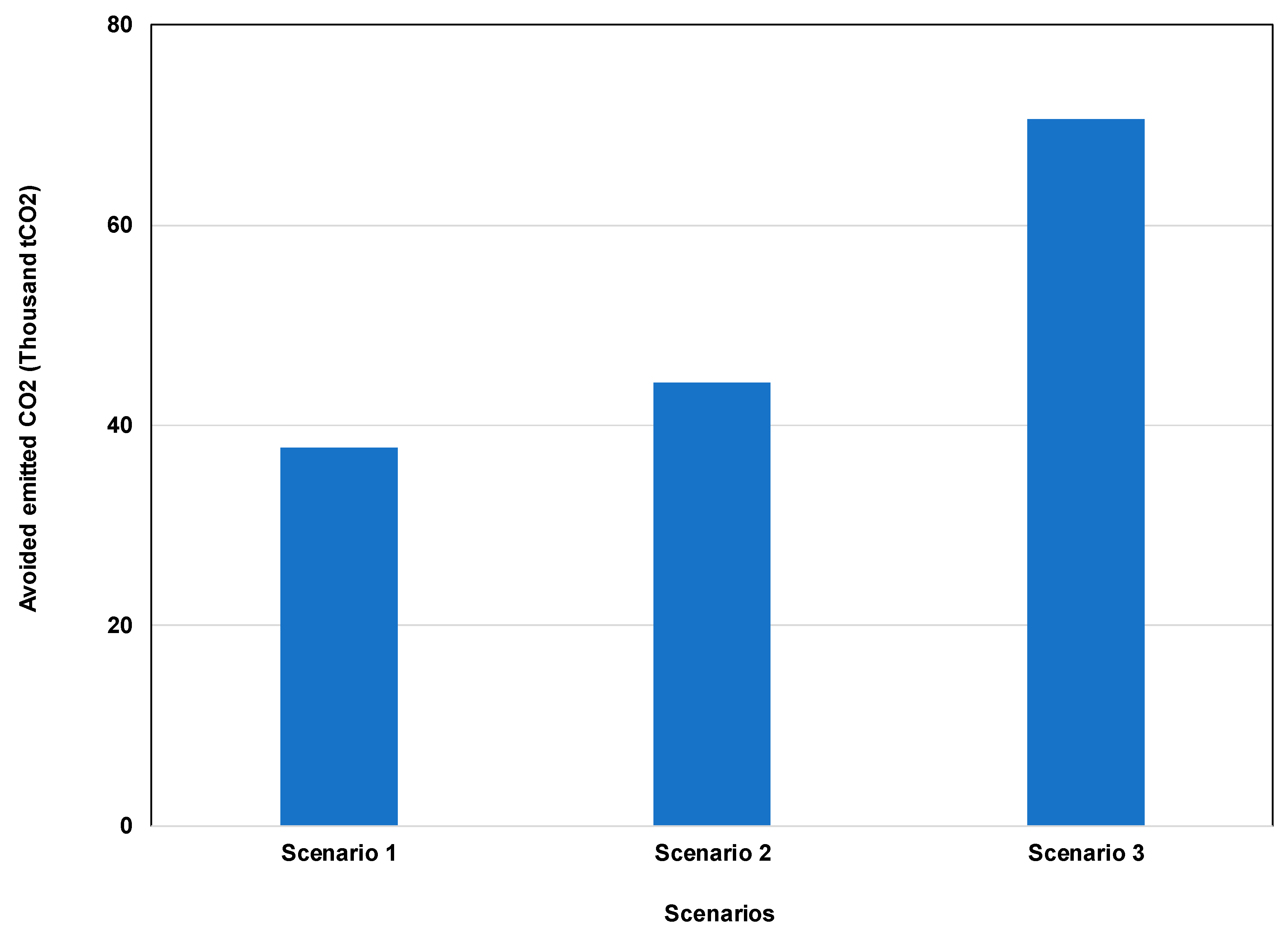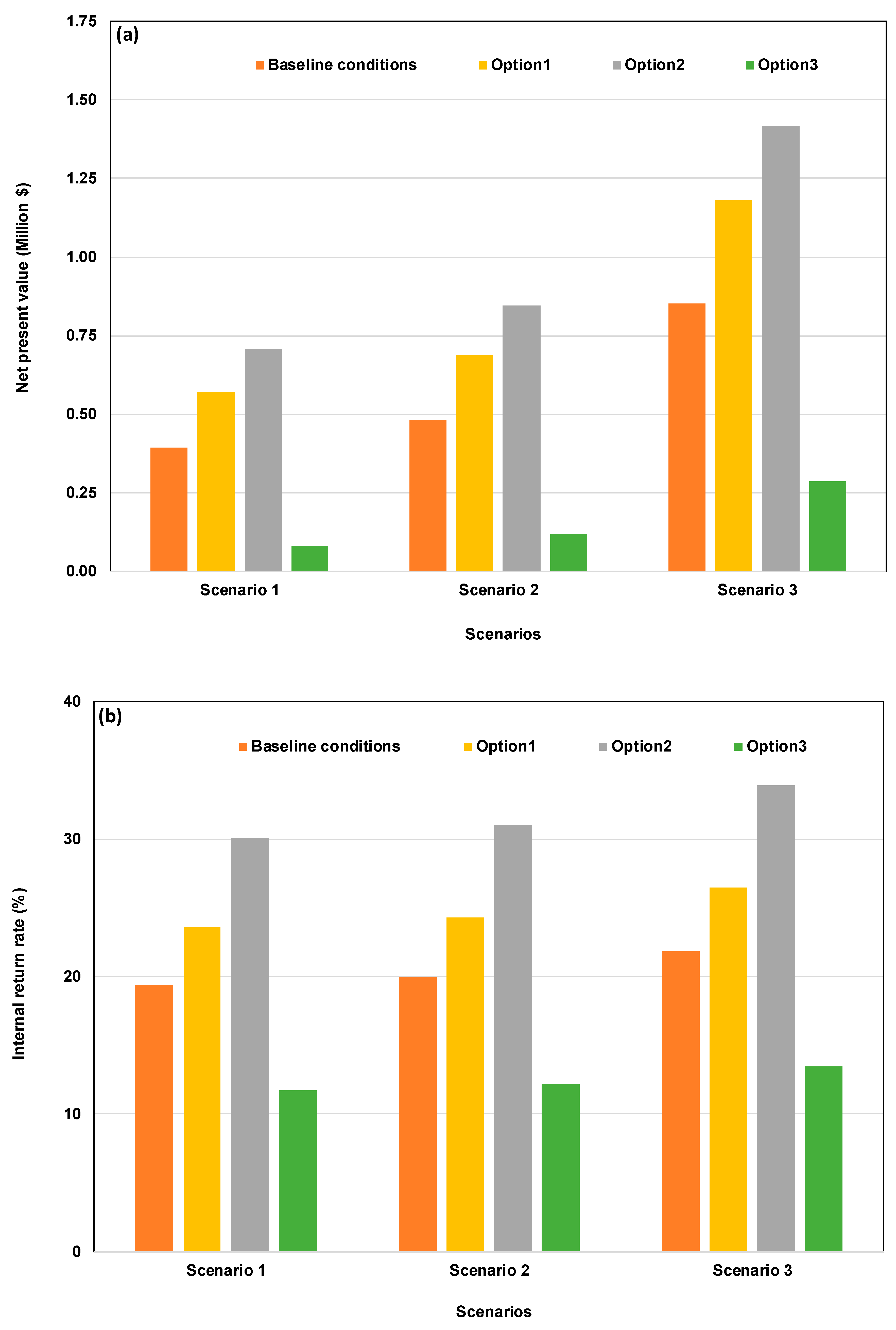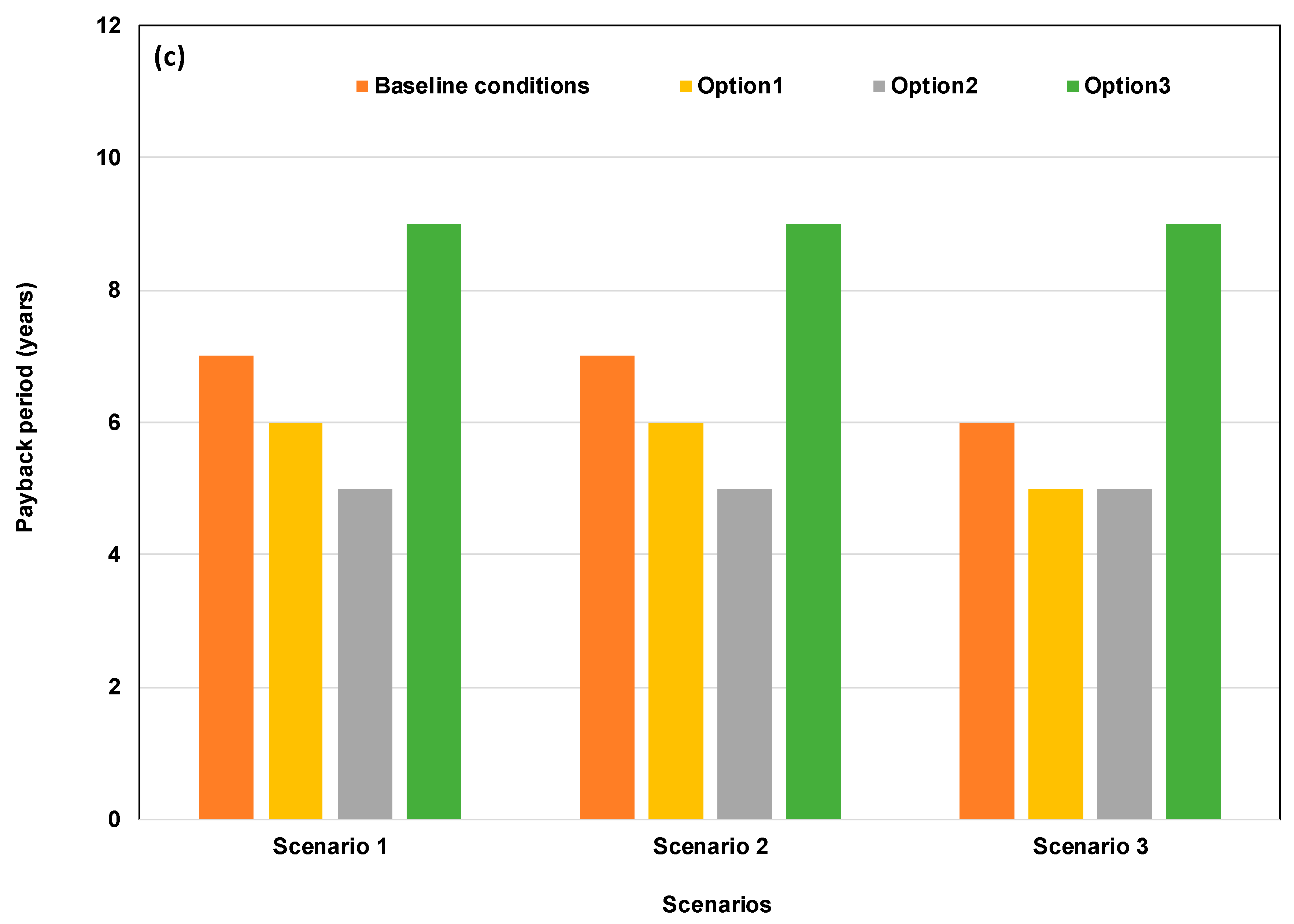Investigations on Biogas Recovery from Anaerobic Digestion of Raw Sludge and Its Mixture with Agri-Food Wastes: Application to the Largest Industrial Estate in Oman
Abstract
1. Introduction
2. Materials and Methods
2.1. WWTP of the Al Russayl Industrial Estate
2.2. Preliminary Characterization of Sludge
2.3. Methods and Data Used for the Feasibility Study
- The digester price was evaluated according to the empirical formula given by Bidart et al. [37]:where is the produced biogas amount per hour (m3 h−1).
- The annual costs related to the digester’s operating and maintenance were fixed to 3% of the capital investment. It is in agreement with the one proposed by Martin [39] and exists in the proposed range by the United States Department of Agriculture (USDA, 2007). This value is higher than the proposed rate suggested by Mohammed et al. [29] when carrying out a feasibility study of biogas integration into Ghana’s waste treatment plants (1%).
- The electricity production revenue (EPR) is equal to the produced amount multiplied by its selling price. This price was fixed to $0.138 kWh−1, which is $0.01 lower than the current price by the Omani electricity distribution company ($0.148 kWh−1).
- The Certified Emissions Reduction (CER) benefits due to electricity generation from biogas. It is equal to the produced electricity from biogas multiplied by the electricity grid emission factor (EGEF). This factor depends mainly on the used feedstock and technology for electricity production. The EGEF has decreased significantly during the last two decades due to the adoption of cleaner technologies. In 2016, its average value in Europe was estimated to 0.296 tCO2 MWh−1. It is only 0.113 tCO2 MWh−1 for Finland, 0.440 tCO2 MWh−1 for Germany, but reaches 0.812 tCO2 MWh−1 for Estonia [40]. For Oman’s case, an average value of 0.858 tCO2 MWh−1 was proposed by Charabi et al. [35], corresponding to the use of 97% of natural gas and 3% of diesel for the production of electricity.
2.4. Cost–Benefit Analysis
2.5. Sensitivity Analysis
- -
- Option 1: baseline conditions + generated electricity sold at the current price applied by the Omani distribution company: $0.148 (7.25% higher than the one used for the baseline conditions)
- -
- Option 2: Baseline conditions + annual expenses decrease by 15%
- -
- Option 3: Baseline conditions + annual expenses increase by 15%
3. Results and Discussions
3.1. Preliminary Physico-Chemical Characterization of Sludge
3.2. Biogas and Electricity Production Capacities
3.3. Emissions Reduction Potential
3.4. Economic Performance
3.5. Sensitivity Analysis Results
4. Conclusions
Author Contributions
Funding
Institutional Review Board Statement
Informed Consent Statement
Data Availability Statement
Acknowledgments
Conflicts of Interest
References
- Gherghel, A.; Teodosiu, C.; De Gisi, S. A review on wastewater sludge valorisation and its challenges in the context of circular economy. J. Clean. Prod. 2019, 228, 244–263. [Google Scholar] [CrossRef]
- Fijalkowski, K.; Rorat, A.; Grobelak, A.; Kacprzak, M.J. The presence of contaminations in sewage sludge—The current situation. J. Environ. Manag. 2017, 203, 1126–1136. [Google Scholar] [CrossRef]
- Collivignarelli, M.C.; Abbà, A.; Miino, M.C.; Torretta, V. What Advanced Treatments Can Be Used to Minimize the Production of Sewage Sludge in WWTPs? Appl. Sci. 2019, 9, 2650. [Google Scholar] [CrossRef]
- European Commission. Environmental, Economic and Social Impacts of the Use of Sewage Sludge on Land. Consultant Report Options Impacts; Report by RPA, Milieu Ltd., WRc and European Commission, DG Environment under Study Contract DG ENV.G.4/ETU/2008/0076r; European Commission: Brussels, Belgium, 2009. [Google Scholar]
- Seleiman, M.F.; Santanen, A.; Mäkelä, P.S.A. Recycling sludge on cropland as fertilizer—Advantages and risks. Resour. Conserv. Recycl. 2020, 155, 104647. [Google Scholar] [CrossRef]
- Chang, Z.; Long, G.; Zhou, J.L.; Ma, C. Valorization of sewage sludge in the fabrication of construction and building materials: A review. Resour. Conserv. Recycl. 2020, 154, 104606. [Google Scholar] [CrossRef]
- Raheem, A.; Sikarwar, V.S.; He, J.; Dastyar, W.; Dionysiou, D.D.; Wang, W.; Zhao, M. Opportunities and challenges in sustainable treatment and resource reuse of sewage sludge: A review. Chem. Eng. J. 2018, 337, 616–641. [Google Scholar] [CrossRef]
- Kor-Bicakci, G.; Eskicioglu, C. Recent developments on thermal municipal sludge pretreatment technologies for enhanced anaerobic digestion. Renew. Sustain. Energy Rev. 2019, 110, 423–443. [Google Scholar] [CrossRef]
- Cao, Y.; Pawłowski, A. Sewage sludge-to-energy approaches based on anaerobic digestion and pyrolysis: Brief overview and energy efficiency assessment. Renew. Sustain. Energy Rev. 2012, 16, 1657–1665. [Google Scholar] [CrossRef]
- Oladejo, J.; Shi, K.; Luo, X.; Yang, G.; Wu, T. A Review of Sludge-to-Energy Recovery Methods. Energies 2019, 12, 60. [Google Scholar] [CrossRef]
- Lee, I.S.; Parameswaran, P.; Rittmann, B.E. Effects of solids retention time on methanogenesis in anaerobic digestion of thickened mixed sludge. Bioresour. Technol. 2011, 102, 10266–10272. [Google Scholar] [CrossRef] [PubMed]
- Aryal, N.; Kvist, T. Alternative of Biogas Injection into the Danish Gas Grid System—A Study from Demand Perspective. ChemEngineering 2018, 2, 43. [Google Scholar] [CrossRef]
- Mills, N.; Pearce, P.; Farrow, J.; Thorpe, R.B.; Kirkby, N.F. Environmental & economic life cycle assessment of current & future sewage sludge to energy technologies. Waste Manag. 2014, 34, 185–195. [Google Scholar] [CrossRef]
- Shen, Y.; Linville, J.L.; Urgun-Demirtas, M.; Mintz, M.M.; Snyder, S.W. An overview of biogas production and utilization at full-scale wastewater treatment plants (WWTPs) in the United States: Challenges and opportunities towards energy-neutral WWTPs. Renew. Sustain. Energy Rev. 2015, 50, 346–362. [Google Scholar] [CrossRef]
- Wei, L.; Zhu, F.; Li, Q.; Xue, C.; Xia, X.; Yu, H.; Zhao, Q.; Jiang, J.; Bai, S. Development, current state and future trends of sludge management in China: Based on exploratory data and CO2-equivaient emissions analysis. Environ. Int. 2020, 144, 106093. [Google Scholar] [CrossRef]
- Scarlat, N.; Dallemand, J.F.; Fahl, F. Biogas: Developments and perspectives in Europe. Renew. Energy 2018, 129, 457–472. [Google Scholar] [CrossRef]
- Werle, S.; Wilk, R.K. A review of methods for the thermal utilization of sewage sludge: The Polish perspective. Renew. Energy 2010, 35, 1914–1919. [Google Scholar] [CrossRef]
- EurObserv’ER Biogas Barometer. EurObserv’ER, 2020. Available online: https://www.eurobserv-er.org/biogas-barometer-2020/ (accessed on 15 March 2021).
- Torres-León, C.; Ramírez-Guzman, N.; Londoño-Hernandez, L.; Martinez-Medina, G.A.; Díaz-Herrera, R.; Navarro-Macias, V.; Alvarez-Pérez, O.B.; Picazo, B.; Villarreal-Vázquez, M.; Ascacio-Valdes, J.; et al. Food Waste and Byproducts: An Opportunity to Minimize Malnutrition and Hunger in Developing Countries. Front. Sustain. Food Syst. 2018, 2, 52. [Google Scholar] [CrossRef]
- Czekała, W. Agricultural Biogas Plants as a Chance for the Development of the Agri-Food Sector. J. Ecol. Eng. 2018, 19, 179–183. [Google Scholar] [CrossRef]
- Król, K.; Iskra, K.; Ferens, W.; Miodoński, J.M. Testing properties of sewage sludge for energy use. Environ. Prot. Eng. 2019, 45, epe190405. [Google Scholar] [CrossRef]
- Ahmad, N.; Sahrin, N.; Talib, N.; Abdul Ghani, F. Characterization of energy content in food waste by using thermogravimetric analyser (TGA) and elemental analyser (CHNS-O). J. Phys. Conf. Ser. 2019, 1349, 012140. [Google Scholar] [CrossRef]
- Zhang, C.; Su, H.; Baeyens, J.; Tan, T. Reviewing the anaerobic digestion of food waste for biogas production. Renew. Sustain. Energy Rev. 2014, 38, 383–392. [Google Scholar] [CrossRef]
- Kuo, J.; Dow, J. Biogas production from anaerobic digestion of food waste and relevant air quality implications. J. Air Waste Manag. Assoc. 2017, 67, 1000–1011. [Google Scholar] [CrossRef] [PubMed]
- Bertanza, G.; Canato, M.; Laera, G. Towards energy self-sufficiency and integral material recovery in waste water treatment plants: Assessment of upgrading options. J. Clean. Prod. 2018, 170, 1206–1218. [Google Scholar] [CrossRef]
- Keucken, A.; Habagil, M.; Batstone, D.; Jeppsson, U.; Arnell, M. Anaerobic Co-Digestion of Sludge and Organic Food Waste—Performance, Inhibition, and Impact on the Microbial Community. Energies 2018, 11, 2325. [Google Scholar] [CrossRef]
- Guimarães, C.D.S.; Maia, D.R.D.S.; Serra, E.G. Construction of Biodigesters to Optimize the Production of Biogas from Anaerobic Co-Digestion of Food Waste and Sewage. Energies 2018, 11, 870. [Google Scholar] [CrossRef]
- Morales-Polo, C.; del Mar Cledera-Castro, M.; Soria, B.Y.M. Reviewing the Anaerobic Digestion of Food Waste: From Waste Generation and Anaerobic Process to Its Perspectives. Appl. Sci. 2018, 8, 1804. [Google Scholar] [CrossRef]
- Mohammed, M.; Egyir, I.S.; Donkor, A.K.; Amoah, P.; Nyarko, S.; Boateng, K.K.; Ziwu, C. Feasibility study for biogas integration into waste treatment plants in Ghana. Egypt. J. Pet. 2017, 26, 695–703. [Google Scholar] [CrossRef]
- Khadhar, S.; Sdiri, A.; Chekirben, A.; Azouzi, R.; Charef, A. Integration of sequential extraction, chemical analysis and statistical tools for the availability risk assessment of heavy metals in sludge amended soils. Environ. Pollut. 2020, 263, 114543. [Google Scholar] [CrossRef]
- Chow, W.L.; Chong, S.; Lim, J.W.; Chan, Y.J.; Chong, M.F.; Tiong, T.J.; Chin, J.K.; Pan, G.T. Anaerobic Co-Digestion of Wastewater Sludge: A Review of Potential Co-Substrates and Operating Factors for Improved Methane Yield. Processes 2020, 8, 39. [Google Scholar] [CrossRef]
- Islam, M.N.; Park, K.-J.; Yoon, H.-S. Methane Production Potential of Food Waste and Food Waste Mixture with Swine Manure in Anaerobic Digestion. J. Biosyst. Eng. 2012, 37, 100–105. [Google Scholar] [CrossRef]
- Zhang, C.; Su, H.; Tan, T. Batch and semi-continuous anaerobic digestion of food waste in a dual solid-liquid system. Bioresour. Technol. 2013, 145, 10–16. [Google Scholar] [CrossRef] [PubMed]
- Akbulut, A. Techno-economic analysis of electricity and heat generation from farm-scale biogas plant: Çiçekdağı case study. Energy 2012, 44, 381–390. [Google Scholar] [CrossRef]
- Charabi, Y.; Al-Awadhi, T.; Choudri, B.S. Strategic pathways and regulatory choices for effective GHG reduction in hydrocarbon based economy: Case of Oman. Energy Rep. 2018, 4, 653–659. [Google Scholar] [CrossRef]
- Hamrick, K.; Gallant, M. State of the Voluntary Carbon Markets 2017; International Water Power & Dam Construction: London, UK, 2017. [Google Scholar]
- Bidart, C.; Fröhling, M.; Schultmann, F. Electricity and substitute natural gas generation from the conversion of wastewater treatment plant sludge. Appl. Energy 2014, 113, 404–413. [Google Scholar] [CrossRef]
- Morin, P.; Marcos, B.; Moresoli, C.; Laflamme, C.B. Economic and environmental assessment on the energetic valorization of organic material for a municipality in Quebec, Canada. Appl. Energy 2010, 87, 275–283. [Google Scholar] [CrossRef]
- Martin, J.H.; Oemler, J.A. A Protocol for Quantifying and Reporting the Performance of Anaerobic Digestion Systems for Livestock Manures. In Proceedings of the International Symposium on Air Quality and Waste Management for Agriculture, Broomfield, CO, USA, 16–19 September 2007. [Google Scholar]
- European Environment Agency. EEA Greenhouse Gas—Data Viewer. Data Viewer Greenhouse Gas Emissions and Removals, Sent by Countries to UNFCCC EU Greenhouse Gas Monitoring Mechanism (EU Member States); European Environment Agency: Copenhagen, Denmark, 2019. [Google Scholar]
- Adani, F.; Tambone, F. Long-term effect of sewage sludge application on soil humic acids. Chemosphere 2005, 60, 1214–1221. [Google Scholar] [CrossRef] [PubMed]
- Zhang, J.; Sugir, M.E.; Li, Y.; Yuan, L.; Zhou, M.; Lv, P.; Yu, Z.; Wang, L.; Zhou, D. Effects of vermicomposting on the main chemical properties and bioavailability of Cd/Zn in pure sludge. Environ. Sci. Pollut. Res. 2019, 26, 20949–20960. [Google Scholar] [CrossRef] [PubMed]
- Janowska, B.; Szymański, K.; Sidełko, R.; Siebielska, I.; Walendzik, B. Assessment of mobility and bioavailability of mercury compounds in sewage sludge and composts. Environ. Res. 2017, 156, 394–403. [Google Scholar] [CrossRef]
- Collivignarelli, M.C.; Abbà, A.; Frattarola, A.; Miino, M.C.; Padovani, S.; Katsoyiannis, I.; Torretta, V. Legislation for the Reuse of Biosolids on Agricultural Land in Europe: Overview. Sustainability 2019, 11, 6015. [Google Scholar] [CrossRef]
- Verbinnen, B.; Block, C.; Hannes, D.; Lievens, P.; Vaclavikova, M.; Stefusova, K.; Gallios, G.; Vandecasteele, C. Removal of Molybdate Anions from Water by Adsorption on Zeolite-Supported Magnetite. Water Environ. Res. 2012, 84, 753–760. [Google Scholar] [CrossRef] [PubMed]
- Zhu, H.; Huang, Q.; Fu, S.; Zhang, X.; Shi, M.; Liu, B. Removal of Molybdenum(VI) from Raw Water Using Nano Zero-Valent Iron Supported on Activated Carbon. Water 2020, 12, 3162. [Google Scholar] [CrossRef]
- Council of European Communities. Council Directive 86/278/EEC of 12 June 1986 on the protection of the environment, and in particular of the soil, when sewage sludge is used in agriculture. Off. J. Eur. Communities 1986, 86, 278. [Google Scholar]
- Baawain, M.S.; Al-Jabri, M.; Choudri, B.S. Characterization of Industrial Wastewater Sludge in Oman from Three Different Regions and Recommendations for Alternate Reuse Applications. Iran. J. Public Health 2015, 44, 1473–1481. [Google Scholar]
- Alrawashdeh, K.A.B.; Gul, E.; Yang, Q.; Yang, H.; Bartocci, P.; Fantozzi, F. Effect of Heavy Metals in the Performance of Anaerobic Digestion of Olive Mill Waste. Processes 2020, 8, 1146. [Google Scholar] [CrossRef]
- Abdel-Shafy, H.I.; Mansour, M.S.M. Biogas production as affected by heavy metals in the anaerobic digestion of sludge. Egypt. J. Pet. 2014, 23, 409–417. [Google Scholar] [CrossRef]
- Appels, L.; Baeyens, J.; Degrève, J.; Dewil, R. Principles and potential of the anaerobic digestion of waste-activated sludge. Prog. Energy Combust. Sci. 2008, 34, 755–781. [Google Scholar] [CrossRef]
- Berktay, A.; Nas, B. Biogas Production and Utilization Potential of Wastewater Treatment Sludge. Energy Sources Part A Recover. Util. Environ. Eff. 2008, 30, 179–188. [Google Scholar] [CrossRef]
- Gurieff, N.; Bruus, J.; Nielsen, B.; Nawawi-Lansade, D.; Cantegril, M. Moving towards an energy neutral WWTP—The positive impact of ExelysTM continuous thermal hydrolysis in achieving this goal. Water Pr. Technol. 2012, 7, 1–8. [Google Scholar] [CrossRef]
- Tarallo, S. Demonstrated Energy Neutrality Leadership: A Study of Five Champions of Change. Water Intell. Online 2015, 14. [Google Scholar] [CrossRef]
- Bachmann, N. Sustainable Biogas Production in Municipal Wastewater Treatment Plants; IEA Bioenergy: Massongex, Switzerland, 2015. [Google Scholar]
- Mattioli, A.; Gatti, G.B.; Mattuzzi, G.P.; Cecchi, F.; Bolzonella, D. Co-digestion of the organic fraction of municipal solid waste and sludge improves the energy balance of wastewater treatment plants: Rovereto case study. Renew. Energy 2017, 113, 980–988. [Google Scholar] [CrossRef]
- Koch, K.; Plabst, M.; Schmidt, A.; Helmreich, B.; Drewes, J.E. Co-digestion of food waste in a municipal wastewater treatment plant: Comparison of batch tests and full-scale experiences. Waste Manag. 2016, 47, 28–33. [Google Scholar] [CrossRef] [PubMed]
- Maktabifard, M.; Zaborowska, E.; Makinia, J. Achieving energy neutrality in wastewater treatment plants through energy savings and enhancing renewable energy production. Rev. Environ. Sci. Biotechnol. 2018, 17, 655–689. [Google Scholar] [CrossRef]
- Koch, K.; Helmreich, B.; Drewes, J.E. Co-digestion of food waste in municipal wastewater treatment plants: Effect of different mixtures on methane yield and hydrolysis rate constant. Appl. Energy 2015, 137, 250–255. [Google Scholar] [CrossRef]
- Eggleston, H.S.; Buendia, L.; Miwa, K.; Ngara, T.; Tanabe, K. Energy. In IPCC Guidelines for National Greenhouse Gas Inventories; IPCC: Geneva, Switzerland, 2006; Volume 2. [Google Scholar]
- Parravicini, V.; Svardal, K.; Krampe, J. Greenhouse Gas Emissions from Wastewater Treatment Plants. Energy Procedia 2016, 97, 246–253. [Google Scholar] [CrossRef]
- Chai, C.; Zhang, D.; Yu, Y.; Feng, Y.; Wong, M.S. Carbon Footprint Analyses of Mainstream Wastewater Treatment Technologies under Different Sludge Treatment Scenarios in China. Water 2015, 7, 918–938. [Google Scholar] [CrossRef]
- Law, Y.; Ye, L.; Pan, Y.; Yuan, Z. Nitrous oxide emissions from wastewater treatment processes. Philos. Trans. R. Soc. B Biol. Sci. 2012, 367, 1265–1277. [Google Scholar] [CrossRef]
- Yoshida, H.; Mønster, J.; Scheutz, C. Plant-integrated measurement of greenhouse gas emissions from a municipal wastewater treatment plant. Water Res. 2014, 61, 108–118. [Google Scholar] [CrossRef] [PubMed]
- Edwards, J.; Othman, M.; Burn, S. A review of policy drivers and barriers for the use of anaerobic digestion in Europe, the United States and Australia. Renew. Sustain. Energy Rev. 2015, 52, 815–828. [Google Scholar] [CrossRef]
- Alhammad, Z. Feasibility Study for a Biogas Plant in Jordan. J. Energy Res. Rev. 2019, 1–6. [Google Scholar] [CrossRef]







| Biogas Generation | Reference | |
|---|---|---|
| Parameter | Value | |
| Project duration (years) | 20 | This study, baseline option |
| Initial raw sludge flow rate (2021) (m3 day−1)—Scenario 1 | 240.0 | Internal report |
| Average solid matter content in raw sludge (%) | 3.5 | Internal report; [9,10] |
| Solid dry matter amount in the first year of the project (tonnes day−1) | 8.4 | Internal report |
| Annual increase of sludge flow rate (%) | 2 | This study, baseline option |
| Average annual dry sludge flow rate (2021–2040) (m3 year−1)—Scenario 1 | 3724.8 | This study, baseline option |
| Density of thickened sludge (kg m−3) | 1020 | [10] |
| Solid matter content in the thickened sludge (%) | 25 | [9] |
| Volatile matter (VM) content in sludge (%) | 45.0 | [10] |
| Volatile matter conversion rate of sludge (%) | 45.0 | [25] |
| C/N ratio range | 6–10 | [31] |
| Biogas production per kg of degraded VM of sludge (m3 kg−1) | 1.0 | [9,24] |
| Initial AFW flow rate (2021) (tonnes day−1), wet basis—Scenario 2 | 2.0 | This study, baseline option |
| Solid matter content in agri-food wastes (%) | 20.0 | [32,33] |
| Initial AFW flow rate (2021) (tonnes day−1), dry basis—Scenario 2 | 0.4 | This study, baseline option |
| Annual increase of AFW used flow rate (%) | 2.0 | |
| Average annual dry AFW flow rate (2021–2040) (m3 year−1)—Scenario 2 | 177.4 | |
| Initial AFW flow rate (2021) (tonnes day−1), wet basis—Scenario 3 | 10.0 | |
| Initial AFW flow rate (2021) (tonnes day−1), dry basis—Scenario 3 | 2.0 | |
| Average annual dry AFW flow rate (2021–2040) (m3 year−1)—Scenario 3 | 886.9 | |
| Volatile matter content in agri food waste (%) | 90.0 | [33] |
| Volatile matter of AFW conversion rate (%) | 75.0 | [24] |
| C/N ratio range | 11–21 | [31] |
| Biogas production per kg of degraded VM of food wastes (m3 kg−1) | 1.1 | [24] |
| Electricity generation | ||
| Methane content in biogas (%) | 65.0 | [24] |
| Lower methane energy content (MJ m−3) | 35.8 | [21] |
| Thermal conversion factor (%) | 45.0 | [34] |
| Gas emission reduction | ||
| Electricity Grid emission factor (tCO2 MWh−1) | 0.858 | [35] |
| Sludge transport factor (tCO2 per 1000 km) | 0.113 | This study, baseline option |
| Emission reduction benefits rate ($per tCO2) | 2.587 | [36] |
| Electricity selling | ||
| Omani electricity price for businesses ($kWh−1) | 0.148 | Internal report |
| Produced electricity from biogas selling price ($kWh−1) | 0.138 | In this study, the baseline option |
| Metal | Content (mg kg−1) | Omani Standard | Ratio (Omani Standard/Measured Content) | European Standard |
|---|---|---|---|---|
| Arsenic | <4 | - | - | - |
| Boron | 20 | - | - | - |
| Barium | 49 | - | - | - |
| Cadmium | <4 | 20 | - | 20–40 |
| Cobalt | 2 | - | - | - |
| Chromium | 190 | 1000 | 5.3 | - |
| Copper | 280 | 1000 | 3.6 | 1000–1750 |
| Mercury | 0.1 | 10 | 100 | 16–25 |
| Manganese | 210 | - | - | - |
| Molybdenum | 36 | 20 | 0.6 | - |
| Nickel | 29 | 300 | 10.3 | 300–400 |
| Lead | 90 | 1000 | 11.1 | 750–1200 |
| Antimony | <7 | - | - | - |
| Selenium | <2 | 50 | - | - |
| Vanadium | 12 | - | - | - |
| Zinc | 270 | 3000 | 11.1 | 2500–4000 |
| Total cyanide | <0.5 | - | - | - |
| Fluorides | <500 | - | - | - |
| Scenario 1 | Scenario 2 | Scenario 3 | |
|---|---|---|---|
| Average annual produced biogas (Mm3 year−1) | 0.754 | 0.886 | 1.413 |
| Total biogas amount during the project lifetime (Mm3) | 15.085 | 17.719 | 28.255 |
| Average annual produced methane (Mm3 year−1) | 0.490 | 0.576 | 0.918 |
| Total methane produced amount during the project lifetime (Mm3) | 9.806 | 11.518 | 18.366 |
| Average annual produced electricity (GWh year−1) | 2.195 | 2.578 | 4.111 |
| Total produced electricity during the project lifetime (GWh) | 43.892 | 51.555 | 82.210 |
| NPV ($ Million) | IRR (%) | PBP | ||
|---|---|---|---|---|
| Baseline option | Scenario 1 | 0.393 | 19.4 | 7 |
| Scenario 2 | 0.481 | 20.0 | 7 | |
| Scenario 3 | 0.852 | 21.8 | 6 | |
| Option 1: Generated electricity sold for $0.148 kWh−1 | Scenario 1 | 0.569 | 23.6 | 6 |
| Scenario 2 | 0.688 | 24.3 | 6 | |
| Scenario 3 | 1.181 | 26.5 | 5 | |
| Option 2: Total expenses decrease by 15% | Scenario 1 | 0.706 | 30.1 | 5 |
| Scenario 2 | 0.845 | 31.0 | 5 | |
| Scenario 3 | 1.419 | 33.9 | 5 | |
| Option 3: Total expenses increase by 15% | Scenario 1 | 0.081 | 11.7 | 9 |
| Scenario 2 | 0.117 | 12.2 | 9 | |
| Scenario 3 | 0.285 | 13.5 | 9 |
Publisher’s Note: MDPI stays neutral with regard to jurisdictional claims in published maps and institutional affiliations. |
© 2021 by the authors. Licensee MDPI, Basel, Switzerland. This article is an open access article distributed under the terms and conditions of the Creative Commons Attribution (CC BY) license (http://creativecommons.org/licenses/by/4.0/).
Share and Cite
Jellali, S.; Charabi, Y.; Usman, M.; Al-Badi, A.; Jeguirim, M. Investigations on Biogas Recovery from Anaerobic Digestion of Raw Sludge and Its Mixture with Agri-Food Wastes: Application to the Largest Industrial Estate in Oman. Sustainability 2021, 13, 3698. https://doi.org/10.3390/su13073698
Jellali S, Charabi Y, Usman M, Al-Badi A, Jeguirim M. Investigations on Biogas Recovery from Anaerobic Digestion of Raw Sludge and Its Mixture with Agri-Food Wastes: Application to the Largest Industrial Estate in Oman. Sustainability. 2021; 13(7):3698. https://doi.org/10.3390/su13073698
Chicago/Turabian StyleJellali, Salah, Yassine Charabi, Muhammad Usman, Abdullah Al-Badi, and Mejdi Jeguirim. 2021. "Investigations on Biogas Recovery from Anaerobic Digestion of Raw Sludge and Its Mixture with Agri-Food Wastes: Application to the Largest Industrial Estate in Oman" Sustainability 13, no. 7: 3698. https://doi.org/10.3390/su13073698
APA StyleJellali, S., Charabi, Y., Usman, M., Al-Badi, A., & Jeguirim, M. (2021). Investigations on Biogas Recovery from Anaerobic Digestion of Raw Sludge and Its Mixture with Agri-Food Wastes: Application to the Largest Industrial Estate in Oman. Sustainability, 13(7), 3698. https://doi.org/10.3390/su13073698








